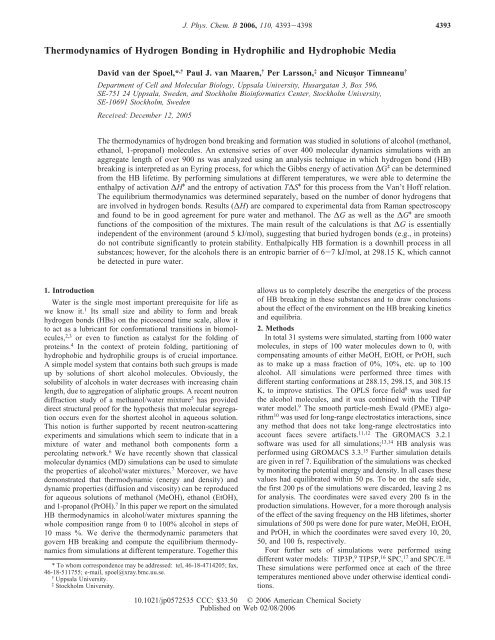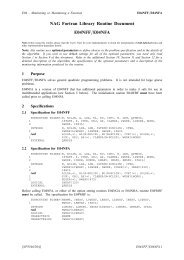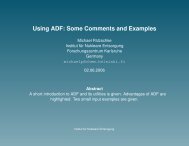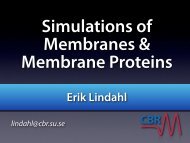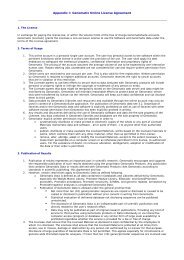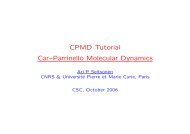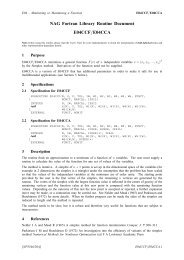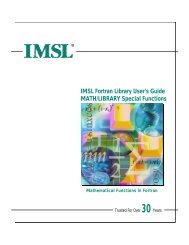Thermodynamics of Hydrogen Bonding in Hydrophilic and ...
Thermodynamics of Hydrogen Bonding in Hydrophilic and ...
Thermodynamics of Hydrogen Bonding in Hydrophilic and ...
Create successful ePaper yourself
Turn your PDF publications into a flip-book with our unique Google optimized e-Paper software.
J. Phys. Chem. B 2006, 110, 4393-4398<br />
4393<br />
<strong>Thermodynamics</strong> <strong>of</strong> <strong>Hydrogen</strong> <strong>Bond<strong>in</strong>g</strong> <strong>in</strong> <strong>Hydrophilic</strong> <strong>and</strong> Hydrophobic Media<br />
David van der Spoel,* ,† Paul J. van Maaren, † Per Larsson, ‡ <strong>and</strong> Nicuşor Tîmneanu †<br />
Department <strong>of</strong> Cell <strong>and</strong> Molecular Biology, Uppsala UniVersity, Husargatan 3, Box 596,<br />
SE-751 24 Uppsala, Sweden, <strong>and</strong> Stockholm Bio<strong>in</strong>formatics Center, Stockholm UniVersity,<br />
SE-10691 Stockholm, Sweden<br />
ReceiVed: December 12, 2005<br />
The thermodynamics <strong>of</strong> hydrogen bond break<strong>in</strong>g <strong>and</strong> formation was studied <strong>in</strong> solutions <strong>of</strong> alcohol (methanol,<br />
ethanol, 1-propanol) molecules. An extensive series <strong>of</strong> over 400 molecular dynamics simulations with an<br />
aggregate length <strong>of</strong> over 900 ns was analyzed us<strong>in</strong>g an analysis technique <strong>in</strong> which hydrogen bond (HB)<br />
break<strong>in</strong>g is <strong>in</strong>terpreted as an Eyr<strong>in</strong>g process, for which the Gibbs energy <strong>of</strong> activation ∆G q can be determ<strong>in</strong>ed<br />
from the HB lifetime. By perform<strong>in</strong>g simulations at different temperatures, we were able to determ<strong>in</strong>e the<br />
enthalpy <strong>of</strong> activation ∆H q <strong>and</strong> the entropy <strong>of</strong> activation T∆S q for this process from the Van’t H<strong>of</strong>f relation.<br />
The equilibrium thermodynamics was determ<strong>in</strong>ed separately, based on the number <strong>of</strong> donor hydrogens that<br />
are <strong>in</strong>volved <strong>in</strong> hydrogen bonds. Results (∆H) are compared to experimental data from Raman spectroscopy<br />
<strong>and</strong> found to be <strong>in</strong> good agreement for pure water <strong>and</strong> methanol. The ∆G as well as the ∆G q are smooth<br />
functions <strong>of</strong> the composition <strong>of</strong> the mixtures. The ma<strong>in</strong> result <strong>of</strong> the calculations is that ∆G is essentially<br />
<strong>in</strong>dependent <strong>of</strong> the environment (around 5 kJ/mol), suggest<strong>in</strong>g that buried hydrogen bonds (e.g., <strong>in</strong> prote<strong>in</strong>s)<br />
do not contribute significantly to prote<strong>in</strong> stability. Enthalpically HB formation is a downhill process <strong>in</strong> all<br />
substances; however, for the alcohols there is an entropic barrier <strong>of</strong> 6-7 kJ/mol, at 298.15 K, which cannot<br />
be detected <strong>in</strong> pure water.<br />
1. Introduction<br />
Water is the s<strong>in</strong>gle most important prerequisite for life as<br />
we know it. 1 Its small size <strong>and</strong> ability to form <strong>and</strong> break<br />
hydrogen bonds (HBs) on the picosecond time scale, allow it<br />
to act as a lubricant for conformational transitions <strong>in</strong> biomolecules,<br />
2,3 or even to function as catalyst for the fold<strong>in</strong>g <strong>of</strong><br />
prote<strong>in</strong>s. 4 In the context <strong>of</strong> prote<strong>in</strong> fold<strong>in</strong>g, partition<strong>in</strong>g <strong>of</strong><br />
hydrophobic <strong>and</strong> hydrophilic groups is <strong>of</strong> crucial importance.<br />
A simple model system that conta<strong>in</strong>s both such groups is made<br />
up by solutions <strong>of</strong> short alcohol molecules. Obviously, the<br />
solubility <strong>of</strong> alcohols <strong>in</strong> water decreases with <strong>in</strong>creas<strong>in</strong>g cha<strong>in</strong><br />
length, due to aggregation <strong>of</strong> aliphatic groups. A recent neutron<br />
diffraction study <strong>of</strong> a methanol/water mixture 5 has provided<br />
direct structural pro<strong>of</strong> for the hypothesis that molecular segregation<br />
occurs even for the shortest alcohol <strong>in</strong> aqueous solution.<br />
This notion is further supported by recent neutron-scatter<strong>in</strong>g<br />
experiments <strong>and</strong> simulations which seem to <strong>in</strong>dicate that <strong>in</strong> a<br />
mixture <strong>of</strong> water <strong>and</strong> methanol both components form a<br />
percolat<strong>in</strong>g network. 6 We have recently shown that classical<br />
molecular dynamics (MD) simulations can be used to simulate<br />
the properties <strong>of</strong> alcohol/water mixtures. 7 Moreover, we have<br />
demonstrated that thermodynamic (energy <strong>and</strong> density) <strong>and</strong><br />
dynamic properties (diffusion <strong>and</strong> viscosity) can be reproduced<br />
for aqueous solutions <strong>of</strong> methanol (MeOH), ethanol (EtOH),<br />
<strong>and</strong> 1-propanol (PrOH). 7 In this paper we report on the simulated<br />
HB thermodynamics <strong>in</strong> alcohol/water mixtures spann<strong>in</strong>g the<br />
whole composition range from 0 to 100% alcohol <strong>in</strong> steps <strong>of</strong><br />
10 mass %. We derive the thermodynamic parameters that<br />
govern HB break<strong>in</strong>g <strong>and</strong> compute the equilibrium thermodynamics<br />
from simulations at different temperature. Together this<br />
* To whom correspondence may be addressed: tel, 46-18-4714205; fax,<br />
46-18-511755; e-mail, spoel@xray.bmc.uu.se.<br />
† Uppsala University.<br />
‡ Stockholm University.<br />
allows us to completely describe the energetics <strong>of</strong> the process<br />
<strong>of</strong> HB break<strong>in</strong>g <strong>in</strong> these substances <strong>and</strong> to draw conclusions<br />
about the effect <strong>of</strong> the environment on the HB break<strong>in</strong>g k<strong>in</strong>etics<br />
<strong>and</strong> equilibria.<br />
2. Methods<br />
In total 31 systems were simulated, start<strong>in</strong>g from 1000 water<br />
molecules, <strong>in</strong> steps <strong>of</strong> 100 water molecules down to 0, with<br />
compensat<strong>in</strong>g amounts <strong>of</strong> either MeOH, EtOH, or PrOH, such<br />
as to make up a mass fraction <strong>of</strong> 0%, 10%, etc. up to 100<br />
alcohol. All simulations were performed three times with<br />
different start<strong>in</strong>g conformations at 288.15, 298.15, <strong>and</strong> 308.15<br />
K, to improve statistics. The OPLS force field 8 was used for<br />
the alcohol molecules, <strong>and</strong> it was comb<strong>in</strong>ed with the TIP4P<br />
water model. 9 The smooth particle-mesh Ewald (PME) algorithm<br />
10 was used for long-range electrostatics <strong>in</strong>teractions, s<strong>in</strong>ce<br />
any method that does not take long-range electrostatics <strong>in</strong>to<br />
account faces severe artifacts. 11,12 The GROMACS 3.2.1<br />
s<strong>of</strong>tware was used for all simulations; 13,14 HB analysis was<br />
performed us<strong>in</strong>g GROMACS 3.3. 15 Further simulation details<br />
are given <strong>in</strong> ref 7. Equilibration <strong>of</strong> the simulations was checked<br />
by monitor<strong>in</strong>g the potential energy <strong>and</strong> density. In all cases these<br />
values had equilibrated with<strong>in</strong> 50 ps. To be on the safe side,<br />
the first 200 ps <strong>of</strong> the simulations were discarded, leav<strong>in</strong>g 2 ns<br />
for analysis. The coord<strong>in</strong>ates were saved every 200 fs <strong>in</strong> the<br />
production simulations. However, for a more thorough analysis<br />
<strong>of</strong> the effect <strong>of</strong> the sav<strong>in</strong>g frequency on the HB lifetimes, shorter<br />
simulations <strong>of</strong> 500 ps were done for pure water, MeOH, EtOH,<br />
<strong>and</strong> PrOH, <strong>in</strong> which the coord<strong>in</strong>ates were saved every 10, 20,<br />
50, <strong>and</strong> 100 fs, respectively.<br />
Four further sets <strong>of</strong> simulations were performed us<strong>in</strong>g<br />
different water models: TIP3P, 9 TIP5P, 16 SPC, 17 <strong>and</strong> SPC/E. 18<br />
These simulations were performed once at each <strong>of</strong> the three<br />
temperatures mentioned above under otherwise identical conditions.<br />
10.1021/jp0572535 CCC: $33.50 © 2006 American Chemical Society<br />
Published on Web 02/08/2006
4394 J. Phys. Chem. B, Vol. 110, No. 9, 2006 van der Spoel et al.<br />
Figure 1. (a) HB angle distribution <strong>in</strong> water from NMR experiments 21<br />
<strong>and</strong> from simulation us<strong>in</strong>g the TIP4P 9 model. (b) Donor-acceptor<br />
distance. In the experimental source 21 the hydrogen-acceptor distance<br />
was determ<strong>in</strong>ed. The whole figure was shifted by 0.089 nm such that<br />
the peak lies at 0.275 nm, correspond<strong>in</strong>g to the peak <strong>in</strong> the experimental<br />
radial distribution function. 23<br />
Figure 2. Number <strong>of</strong> HBs, N hb, m<strong>in</strong>us the theoretical maximum, N max,<br />
per molecule <strong>in</strong> four categories: (a) alcohol-alcohol; (b) alcoholwater;<br />
(c) water-water; (d) total. There is a surplus <strong>in</strong> alc-alc <strong>and</strong><br />
alc-wat HBs, up until a 70-80 mass %.<br />
3. Results<br />
3.1. Number <strong>of</strong> <strong>Hydrogen</strong> Bonds. HBs can be def<strong>in</strong>ed <strong>in</strong><br />
different ways, either based on geometrysdonor-hydrogenacceptor<br />
(DHA) angle <strong>and</strong> donor-acceptor (DA) or hydrogenacceptor<br />
(HA) distancesor based on <strong>in</strong>teraction energy <strong>and</strong><br />
distance (although the differences are m<strong>in</strong>or 19 ). For comparison<br />
with earlier studies we employed a geometrical criterion with a<br />
maximum DA distance <strong>of</strong> 0.35 nm <strong>and</strong> a DHA angle <strong>of</strong> 30°.<br />
With this def<strong>in</strong>ition we reproduce exactly the average number<br />
<strong>of</strong> HBs per molecule <strong>in</strong> pure TIP4P water (1.77) <strong>of</strong> Xu <strong>and</strong><br />
Berne. 20 The distribution <strong>of</strong> HB geometries <strong>in</strong> water was<br />
determ<strong>in</strong>ed experimentally recently 21 us<strong>in</strong>g an <strong>in</strong>novative nuclear<br />
magnetic resonance technique. 22 If we compare the experimental<br />
HB geometry with the simulated one (Figure 1), we see that<br />
the DHA angle distributions are similar but the experimental<br />
one falls <strong>of</strong>f more rapidly. The DA distance distribution also<br />
shows these features, <strong>in</strong>dicat<strong>in</strong>g that the simulation, which<br />
employs effective pair potentials, slightly underestimates the<br />
strength <strong>and</strong> localization <strong>of</strong> the HB.<br />
The numbers <strong>of</strong> HBs per molecule, m<strong>in</strong>us the theoretical<br />
maximum number <strong>of</strong> HBs (N max , see Appendix A), are shown<br />
<strong>in</strong> Figure 2 as a function <strong>of</strong> alcohol mass fraction. The total<br />
number <strong>of</strong> HBs for MeOH/water (Figure 2d) is a straight l<strong>in</strong>e,<br />
<strong>in</strong>dicat<strong>in</strong>g that as far as hydrogen bond<strong>in</strong>g is concerned this is<br />
a perfect mixture. For EtOH <strong>and</strong> PrOH solutions there is a<br />
m<strong>in</strong>imum with respect to a straight l<strong>in</strong>e <strong>in</strong>dicat<strong>in</strong>g that there<br />
are fewer HBs than the theoretical maximum. Both the number<br />
<strong>of</strong> alc-alc <strong>and</strong> alc-wat HBs are found to be higher than those<br />
expected theoretically (parts a <strong>and</strong> b <strong>of</strong> Figure 2). In contrast<br />
the number <strong>of</strong> wat-wat HBs is substantially less than expected<br />
TABLE 1: Un<strong>in</strong>terrupted <strong>Hydrogen</strong> Bond Lifetimes τ 1 at T<br />
) 298.15 K Calculated from Equation 1 from Coord<strong>in</strong>ates<br />
Saved at Interval ∆t a<br />
simulation ∆t ) 0<br />
∆t )<br />
10 fs<br />
∆t )<br />
20 fs<br />
τ 1 (ps)<br />
∆t )<br />
50 fs<br />
∆t )<br />
100 fs<br />
∆t )<br />
200 fs<br />
water 0.15 0.22 0.27 0.46 0.77 1.15<br />
MeOH 0.17 0.33 0.48 0.89 1.44 2.11<br />
EtOH 0.17 0.40 0.59 1.13 1.90 2.71<br />
PrOH 0.21 0.35 0.50 0.98 1.69 2.45<br />
a<br />
To obta<strong>in</strong> a value <strong>of</strong> ∆t ) 0, cubic spl<strong>in</strong>e <strong>in</strong>terpolations through<br />
the five other po<strong>in</strong>ts were made, which were subsequently extrapolated<br />
to ∆t ) 0. The errors <strong>in</strong> these values are less than 1%.<br />
(Figure 2c) which leads to the conclusion that the HB network<br />
<strong>in</strong> water is seriously disrupted upon the addition <strong>of</strong> alcohol<br />
molecules, even though the alcohol molecules are forced<br />
together (Figure 2a).<br />
3.2. <strong>Hydrogen</strong> Bond Lifetimes. HB lifetimes can be<br />
computed <strong>in</strong> different ways, depend<strong>in</strong>g not only on the def<strong>in</strong>ition<br />
<strong>of</strong> the HB that is used (see above) but also on the choice <strong>of</strong><br />
what to regard as a cont<strong>in</strong>uous HB. Should a HB that is broken<br />
accord<strong>in</strong>g to the def<strong>in</strong>ition when it re-forms (somewhat) later<br />
be regarded as the same HB or as a new HB? Both def<strong>in</strong>itions<br />
are tested <strong>and</strong> discussed below.<br />
3.2.1. Cont<strong>in</strong>uous <strong>Hydrogen</strong> Bonds. If one decides that a<br />
HB must exist cont<strong>in</strong>uously (the un<strong>in</strong>terrupted HB 24 ), one can<br />
compute a distribution <strong>of</strong> lifetimes P(t) by mak<strong>in</strong>g a histogram<br />
<strong>of</strong> the number <strong>of</strong> HBs that existed cont<strong>in</strong>uously from time 0 to<br />
t. The probability <strong>of</strong> break<strong>in</strong>g a hydrogen bond is constant <strong>and</strong><br />
<strong>in</strong>dependent <strong>of</strong> the history <strong>of</strong> the bond, <strong>and</strong> hence the tail <strong>of</strong><br />
the P(t) curve should fall <strong>of</strong>f exponentially; 19,25 this is <strong>in</strong>deed<br />
what we f<strong>in</strong>d. The lifetime distribution can be converted <strong>in</strong>to<br />
an autocorrelation function by<br />
C(t) ) 1 - ∫ 0<br />
t<br />
P(τ) dτ (1)<br />
An overall HB lifetime τ 1 can now be associated with the<br />
<strong>in</strong>tegral <strong>of</strong> eq 1<br />
τ 1 ) ∫ 0<br />
∞<br />
C(t) dt (2)<br />
Results for the different systems <strong>and</strong> different frequency <strong>of</strong><br />
sav<strong>in</strong>g ∆t coord<strong>in</strong>ates are given <strong>in</strong> Table 1.<br />
In molecular dynamics simulations one uses a f<strong>in</strong>ite time step<br />
<strong>and</strong> saves coord<strong>in</strong>ates every ∆t (ps), where ∆t is as small as<br />
one can afford <strong>in</strong> terms <strong>of</strong> disk space usage (for the simulations<br />
presented <strong>in</strong> this paper more than 300 GB <strong>of</strong> data were<br />
generated). Obviously P(t), <strong>and</strong> hence τ 1 , depends heavily on<br />
the sav<strong>in</strong>g <strong>in</strong>terval. The reason for this is that if we sample more<br />
<strong>of</strong>ten, any break<strong>in</strong>g event for a HB will shift the P(t) curve to<br />
the left. To get an estimate for the “real” HB lifetime, we have<br />
extrapolated the lifetimes to ∆t ) 0 (us<strong>in</strong>g a cubic spl<strong>in</strong>e<br />
<strong>in</strong>terpolation, Table 1). However, we cannot deduce the zero<strong>in</strong>terval<br />
results for simulations <strong>in</strong> which we have saved<br />
coord<strong>in</strong>ates at 200 fs only (more than 400 production simulations);<br />
for <strong>in</strong>stance, EtOH has a smaller “real” τ 1 than PrOH,<br />
whereas for the simulation where we stored coord<strong>in</strong>ates with<br />
<strong>in</strong>terval ∆t ) 200 fs only, the order is reversed. Starr et al. 19<br />
used the un<strong>in</strong>terrupted HB def<strong>in</strong>ition (the “history-dependent”<br />
HB <strong>in</strong> their term<strong>in</strong>ology) for an analysis <strong>of</strong> supercooled water<br />
<strong>and</strong> sampled the simulation every 10 fs. Accord<strong>in</strong>g to our cubic<br />
spl<strong>in</strong>e <strong>in</strong>terpolation the HB lifetime <strong>in</strong> TIP4P water at a 10 fs<br />
sampl<strong>in</strong>g <strong>in</strong>terval is 0.22 ps, compared to 0.15 ps at 0 fs
<strong>Thermodynamics</strong> <strong>of</strong> <strong>Hydrogen</strong> <strong>Bond<strong>in</strong>g</strong> J. Phys. Chem. B, Vol. 110, No. 9, 2006 4395<br />
sampl<strong>in</strong>g <strong>in</strong>terval (Starr et al. 19 f<strong>in</strong>d 0.27 ps for SPC/E water 18<br />
which has stronger HBs due to larger partial charges). Thus,<br />
even by sampl<strong>in</strong>g 20 times as <strong>of</strong>ten as we did <strong>in</strong> this work<br />
(<strong>in</strong>creas<strong>in</strong>g our comb<strong>in</strong>ed trajectory size to over 2 TB), we<br />
would still not have a good enough approximation <strong>of</strong> the<br />
lifetimes. The un<strong>in</strong>terrupted HB def<strong>in</strong>ition for analysis <strong>of</strong> HB<br />
lifetime distributions therefore should therefore be regarded as<br />
impractical.<br />
3.2.2. Interrupted <strong>Hydrogen</strong> Bonds. If we allow HBs to<br />
break <strong>and</strong> re-form, we can analyze HB lifetimes by def<strong>in</strong><strong>in</strong>g a<br />
b<strong>in</strong>ary function h(t), which is 1 when a H bond is present <strong>and</strong><br />
0 otherwise. 25 The autocorrelation function c h (t) <strong>of</strong>h(t) was<br />
computed <strong>and</strong> averaged over similar types <strong>of</strong> HBs. In the<br />
term<strong>in</strong>ology <strong>of</strong> Luzar, 24 this is the “<strong>in</strong>termittent HB correlation<br />
function”, which by design is <strong>in</strong>sensitive to the sav<strong>in</strong>g frequency<br />
∆t, except for the very shortest times (0 e t e ∆t). S<strong>in</strong>ce the<br />
simulation systems are f<strong>in</strong>ite, the c h (t) do not go to zero <strong>and</strong><br />
the c h (t) have to be scaled to zero at long times. 19 In the<br />
rema<strong>in</strong>der <strong>of</strong> this paper we will use this def<strong>in</strong>ition for the<br />
analysis <strong>of</strong> k<strong>in</strong>etics <strong>and</strong> thermodynamics <strong>of</strong> hydrogen bond<strong>in</strong>g.<br />
3.3. K<strong>in</strong>etics <strong>of</strong> <strong>Hydrogen</strong> <strong>Bond<strong>in</strong>g</strong>. The k<strong>in</strong>etics <strong>of</strong><br />
hydrogen bond breakage <strong>and</strong> re-formation can be derived from<br />
a chemical dynamics analysis. 25,24 Here, a forward rate constant<br />
k for HB breakage <strong>and</strong> a backward rate constant k′ for HB<br />
formation are determ<strong>in</strong>ed from the reactive flux correlation<br />
function K(t)<br />
<strong>and</strong><br />
K(t) )- dc h (t)<br />
dt<br />
where n(t) is the probability that a HB is broken that existed at<br />
t ) 0 but that the two hydrogen bond<strong>in</strong>g groups are still with<strong>in</strong><br />
hydrogen bond<strong>in</strong>g distance. The hydrogen bond lifetime <strong>in</strong> this<br />
scheme is given by the <strong>in</strong>verse forward rate constant<br />
In the Support<strong>in</strong>g Information (Tables 1-3) k <strong>and</strong> k′ are given<br />
as a function <strong>of</strong> concentration <strong>and</strong> for three different temperatures.<br />
The rates decrease monotonically with alcohol concentration;<br />
the forward (break<strong>in</strong>g) rates are 1.7 (MeOH) to 2.2<br />
(EtOH, PrOH) times lower <strong>in</strong> the pure alcohols than <strong>in</strong> water.<br />
As expected, the rates <strong>in</strong>crease with <strong>in</strong>creas<strong>in</strong>g temperature <strong>in</strong><br />
all cases.<br />
3.4. <strong>Thermodynamics</strong> <strong>of</strong> <strong>Hydrogen</strong> Bond Break<strong>in</strong>g. If we<br />
assume that the process <strong>of</strong> HB breakage can be described as an<br />
Eyr<strong>in</strong>g process, we can relate τ HB (eq 2) to the Gibbs energy <strong>of</strong><br />
activation ∆G q<br />
where h is Planck’s constant, k B is Boltzmann’s constant, <strong>and</strong><br />
T is the temperature. We can then derive the activation enthalpy<br />
<strong>of</strong> HB break<strong>in</strong>g ∆H q from the Van’t H<strong>of</strong>f equation<br />
<strong>and</strong> hence the entropy <strong>of</strong> activation T∆S q ) ∆H q - ∆G q . The<br />
thermodynamical parameters are plotted <strong>in</strong> Figure 3 (data <strong>in</strong><br />
(3)<br />
K(t) ) kc h (t) - k′n(t) (4)<br />
τ HB ) 1/k (5)<br />
τ HB ) h<br />
k B T exp ( ∆Gq<br />
k B T )<br />
(6)<br />
∆H q ) ∂(∆Gq /T)<br />
∂(1/T)<br />
(7)<br />
Figure 3. Activation thermodynamics (kJ/mol) as a function <strong>of</strong> alcohol<br />
concentration. Error bars <strong>in</strong> ∆G q are derived from the errors <strong>in</strong> rate<br />
constants determ<strong>in</strong>ed from three simulations. The error bars <strong>in</strong> ∆H q<br />
follow from the temperature derivative <strong>of</strong> the errors <strong>in</strong> ∆G q ; errors <strong>in</strong><br />
T∆S q are assumed to be identical to those <strong>in</strong> the correspond<strong>in</strong>g ∆H q .<br />
the Support<strong>in</strong>g Information, Table 4). For all three alcohols the<br />
∆G q are smooth functions <strong>of</strong> the concentration with a very slight<br />
maximum between 80 <strong>and</strong> 90%. There are maxima for ∆H q at<br />
50% for MeOH, at 60% for EtOH, <strong>and</strong> at 80% for PrOH (but<br />
with considerable error bars). Although the ∆H q are quite high,<br />
especially at <strong>in</strong>termediate to high alcohol concentrations, this<br />
is to a large extent compensated for by the considerable entropy<br />
(T∆S q ) <strong>in</strong>crease upon HB break<strong>in</strong>g.<br />
From the number <strong>of</strong> HBs (N hb , Figure 2) we can <strong>in</strong> pr<strong>in</strong>ciple<br />
derive an equilibrium constant<br />
N hb<br />
k eq )<br />
(8)<br />
N max - N hb<br />
where N max is the maximum number <strong>of</strong> HBs (Appendix A).<br />
However, to be able to compare our results directly to<br />
experimental data from Raman spectroscopy, 26-29 we have to<br />
determ<strong>in</strong>e another parameter, namely, the number <strong>of</strong> donor<br />
hydrogens that are free (not hydrogen bonded), <strong>and</strong> determ<strong>in</strong>e<br />
an equilibrium constant from that<br />
k eq ) N max - N free<br />
N free<br />
(9)<br />
The difference between the two quantities arises from the fact<br />
that accord<strong>in</strong>g to our HB criterion one H may be <strong>in</strong>volved <strong>in</strong><br />
two hydrogen bonds, <strong>and</strong> hence eq 8 will slightly overestimate<br />
k eq . Us<strong>in</strong>g k eq from eq 9 we can determ<strong>in</strong>e the free energy <strong>of</strong><br />
hydrogen bond<strong>in</strong>g<br />
∆G ) k B T ln k eq (10)<br />
The enthalpy ∆H <strong>and</strong> entropy T∆S are aga<strong>in</strong> determ<strong>in</strong>ed from<br />
the Van’t H<strong>of</strong>f equation (cf. eq 7). All results are presented <strong>in</strong><br />
the Support<strong>in</strong>g Information, Table 5.<br />
∆G is a smooth function <strong>of</strong> the alcohol concentration for all<br />
types <strong>of</strong> HBs (Figure 4a). For MeOH <strong>and</strong> EtOH solutions, ∆G<br />
is nearly constant with alcohol concentration <strong>in</strong>dicat<strong>in</strong>g that the<br />
fraction <strong>of</strong> all the possible HBs that is actually formed is<br />
<strong>in</strong>dependent <strong>of</strong> the environment. In PrOH/water ∆G does fall<br />
<strong>of</strong>f somewhat at high alcohol concentration, probably because<br />
it is more difficult to ma<strong>in</strong>ta<strong>in</strong> a high fraction <strong>of</strong> all the possible<br />
HBs. ∆H (Figure 4b) can be directly compared to Raman
4396 J. Phys. Chem. B, Vol. 110, No. 9, 2006 van der Spoel et al.<br />
TABLE 3: Activation <strong>and</strong> Equilibrium <strong>Thermodynamics</strong><br />
(kJ/mol) <strong>of</strong> <strong>Hydrogen</strong> <strong>Bond<strong>in</strong>g</strong> for Different Water Models<br />
at T ) 298.15 K a<br />
model ∆G q ∆H q T∆S q ∆G ∆H T∆S<br />
TIP3P 3.95 4.5 0.5 3.99 7.0 3.0<br />
TIP4P 4.98 8.9 3.9 5.11 9.0 4.1<br />
TIP5P 4.78 14.8 10.0 3.93 11.1 7.2<br />
SPC 4.67 6.8 2.2 4.55 7.8 3.3<br />
SPC/E 5.70 11.3 5.6 5.36 9.0 3.6<br />
a<br />
The errors <strong>in</strong> these numbers are comparable to those <strong>in</strong> Tables 4<br />
<strong>and</strong> 5 (Support<strong>in</strong>g Information), i.e., 0.01 kJ/mol for ∆G q <strong>and</strong> ∆G,<br />
<strong>and</strong> 0.1 kJ/mol for the other values.<br />
Figure 4. Equilibrium thermodynamics (kJ/mol) as a function <strong>of</strong><br />
alcohol concentration. Error bars are computed <strong>in</strong> the same fashion as<br />
those <strong>in</strong> Figure 3.<br />
TABLE 2: Equilibrium Enthalpy (kJ/mol) <strong>of</strong> <strong>Hydrogen</strong><br />
<strong>Bond<strong>in</strong>g</strong> for Pure Substances at T ) 298.15 K a<br />
∆H<br />
sim Raman NMR<br />
water 9.0(0.05) 10.6(0.5) [ref 26]<br />
MeOH 12.6(0.2) 11.3(0.1) [ref 29] 12.8 [ref 39]<br />
EtOH 14.4(0.3) 10.5(0.1) [ref 28] 16.8 [ref 39]<br />
PrOH 14.6(0.5) ≈11 [ref 30]<br />
a<br />
Errors with<strong>in</strong> parentheses, determ<strong>in</strong>ed from a block averag<strong>in</strong>g<br />
procedure. 38 References to the experimental data for ∆H are given.<br />
spectroscopy experiments that track the amount <strong>of</strong> hydrogen<br />
atoms that are hydrogen bonded. 26,27 Table 2 presents a<br />
comprehensive overview <strong>of</strong> simulated <strong>and</strong> experimental results<br />
for the pure liquids. Carey <strong>and</strong> Korenowski f<strong>in</strong>d ∆H for pure<br />
water to be 10.6 ( 0.5 kJ/mol (this work, 9.0 ( 0.05 kJ/mol).<br />
For pure MeOH, Edwards <strong>and</strong> Farwell 29 found 11.3 ( 0.1 kJ/<br />
mol (this work, 12.6 ( 0.1 kJ/mol). The simulation results<br />
correspond very well with the experimental data for these<br />
substances. For EtOH, Edwards et al. found a comparable<br />
number <strong>of</strong> 10.5 kJ/mol 28 (this work, 14.4 ( 0.3) while for PrOH<br />
only an estimate <strong>of</strong> 11 kJ/mol is found 30 (this work, 14.6 (<br />
0.5). Obviously the correspondence for the larger alcohols is<br />
not as good as that for MeOH <strong>and</strong> water. Sun et al. found very<br />
similar values for ∆H (14.7-16.4 kJ/mol) <strong>of</strong> PrOH <strong>in</strong> different<br />
media when they tried to model retention <strong>of</strong> alcohol molecules<br />
<strong>in</strong> gas-liquid chromatography. 31 It has been shown 32 that the<br />
description <strong>of</strong> hydrophobic hydration <strong>in</strong> EtOH solutions can be<br />
improved considerably by us<strong>in</strong>g polarizable models, <strong>and</strong> this is<br />
probably the road to greater accuracy <strong>in</strong> molecular simulation. 32-35<br />
For <strong>in</strong>stance, Figure 1 shows that the localization <strong>of</strong> the HB is<br />
not described sufficiently well us<strong>in</strong>g an empirical nonpolarizable<br />
potential such as TIP4P. F<strong>in</strong>ally, nuclear magnetic resonance<br />
experiments have also been employed <strong>in</strong> order to determ<strong>in</strong>e the<br />
number <strong>of</strong> HBs <strong>in</strong> solution, 36 <strong>and</strong> from these, an estimate <strong>of</strong><br />
∆H was presented. The enthalpies found <strong>in</strong> this manner are<br />
<strong>in</strong>compatible with those found us<strong>in</strong>g Raman spectroscopy as<br />
has been discussed extensively by Lalanne et al., 37 <strong>and</strong> hence<br />
the values determ<strong>in</strong>ed from Raman spectroscopy should probably<br />
be regarded as the reference values.<br />
4. Discussion<br />
For pure water, HB dynamics has been studied by MD<br />
simulations <strong>in</strong> great detail. 19,20,25,40-43 An important observation<br />
by Luzar <strong>and</strong> Ch<strong>and</strong>ler was that the HB k<strong>in</strong>etics is not governed<br />
by a s<strong>in</strong>gle process, s<strong>in</strong>ce the decay <strong>of</strong> the HB correlation<br />
function is not compatible with a s<strong>in</strong>gle exponential. 25 Instead,<br />
they propose a comb<strong>in</strong>ation <strong>of</strong> an exponential process <strong>and</strong> a<br />
diffusive decay (drift<strong>in</strong>g apart <strong>of</strong> two molecules), a mechanism<br />
similar <strong>in</strong> nature to the proposed tetrahedral displacement model<br />
for dielectric relaxation. 44 Us<strong>in</strong>g the Luzar <strong>and</strong> Ch<strong>and</strong>ler<br />
description <strong>of</strong> HB k<strong>in</strong>etics, 25 we have determ<strong>in</strong>ed rate constants<br />
for HB break<strong>in</strong>g <strong>and</strong> re-form<strong>in</strong>g for alcohol solutions at different<br />
temperatures <strong>and</strong> concentrations. The thermodynamics <strong>of</strong> activation<br />
derived from the HB lifetime (eq 5) shows that there is a<br />
considerable enthalpic penalty for HB break<strong>in</strong>g (Figure 3),<br />
particularly <strong>in</strong> the EtOH <strong>and</strong> PrOH solutions. The ∆H q are<br />
compensated for by a considerable <strong>in</strong>crease <strong>in</strong> T∆S q lead<strong>in</strong>g to<br />
a moderate ∆G q vary<strong>in</strong>g from 6 to 7 kJ/mol.<br />
Schre<strong>in</strong>er et al. have recently studied HB dynamics <strong>in</strong> a<br />
peptide/water system. 45 For pure TIP3P 9 water they f<strong>in</strong>d an<br />
activation energy E A <strong>of</strong> 8-9 kJ/mol based on the rate-constant<br />
formalism <strong>of</strong> Luzar <strong>and</strong> Ch<strong>and</strong>ler, 25,24 which is quite a bit lower<br />
than what we f<strong>in</strong>d for TIP4P (E A ) ∆H q + k B T ) 11.4 kJ/<br />
mol). To verify our calculations, we did the same analysis on<br />
a number <strong>of</strong> water models, <strong>in</strong>clud<strong>in</strong>g TIP3P (Table 3). For<br />
TIP3P we f<strong>in</strong>d E A ) 7 kJ/mol, which is close to the value <strong>of</strong><br />
Schre<strong>in</strong>er et al., <strong>and</strong> hence we conclude that our calculations<br />
are correct. The difference may be expla<strong>in</strong>ed by the difference<br />
<strong>in</strong> water models, as TIP3P is known to be quite a bit more<br />
“slippery” than TIP4P. 46 For peptide-peptide HBs Schre<strong>in</strong>er<br />
et al. f<strong>in</strong>d an E A which is remarkably similar (8 kJ/mol) to<br />
water-water HBs but roughly twice as high as peptide-water<br />
HBs. Sheu et al. have reported the activation energies for the<br />
rupture <strong>of</strong> a HB to be 6.6 kJ/mol <strong>in</strong> a β-sheet <strong>and</strong> 8.3 kJ/mol <strong>in</strong><br />
an R-helix. 47 They argue that these values represent Gibbs<br />
energies <strong>of</strong> activation ∆G q rather than ∆H q . These numbers are<br />
somewhat higher than those that we f<strong>in</strong>d for ∆G q : 5.1 kJ/mol<br />
(water), 5.6 kJ/mol (MeOH), 5.6 kJ/mol (EtOH), <strong>and</strong> 4.7 kJ/<br />
mol (PrOH). S<strong>in</strong>ce HB breakage usually takes place by exchange<br />
with another HB, the numbers found for peptides are <strong>in</strong>fluenced<br />
by the water model used <strong>in</strong> the simulations. Obviously the<br />
barrier for break<strong>in</strong>g HBs is much too low <strong>in</strong> TIP3P water (cf.<br />
Tables 2 <strong>and</strong> 3), but how this will affect the simulated HB<br />
break<strong>in</strong>g rates <strong>in</strong> prote<strong>in</strong>s is not clear.<br />
When comb<strong>in</strong><strong>in</strong>g the activation <strong>and</strong> equilibrium thermodynamics,<br />
we can pa<strong>in</strong>t the complete picture <strong>of</strong> hydrogen bond<strong>in</strong>g<br />
(Figure 5). The most important f<strong>in</strong>d<strong>in</strong>g here is that the<br />
equilibrium Gibbs energy ∆G is almost the same for all <strong>of</strong> the<br />
substances, but the ∆G q are somewhat larger <strong>in</strong> nonpolar than<br />
<strong>in</strong> polar environments. In the nonpolar environment there is an<br />
enthalpic penalty for mov<strong>in</strong>g from the transition state to the<br />
unbound state because diffusion <strong>of</strong> hydrogen bond<strong>in</strong>g groups<br />
through hydrophobic media is unfavorable. In watery solutions<br />
<strong>of</strong> alcohols, as <strong>in</strong> solvated peptides, water can mediate HB<br />
reshuffl<strong>in</strong>g <strong>and</strong> “catalyze” the <strong>in</strong>terconversion <strong>of</strong> peptide
<strong>Thermodynamics</strong> <strong>of</strong> <strong>Hydrogen</strong> <strong>Bond<strong>in</strong>g</strong> J. Phys. Chem. B, Vol. 110, No. 9, 2006 4397<br />
for alcohol-water bonds<br />
N max (alc - wat) )<br />
2N a N W (2N a + 4N W - 3)<br />
(N a + N W )(N a + 2N W - 1)(N a + 2N W - 2)<br />
<strong>and</strong> for the total number <strong>of</strong> bonds<br />
Figure 5. <strong>Thermodynamics</strong> along the HB break<strong>in</strong>g pathway <strong>in</strong> pure<br />
fluids: (a) Gibbs energy <strong>and</strong> (b) enthalpy. Indicated on the x-axis are<br />
the reactant state (HB), the transition state (TS), <strong>and</strong> the product state<br />
(free).<br />
structures 2,3 s<strong>in</strong>ce the typical HB lifetimes are on the order <strong>of</strong><br />
2-3 ps (Tables 1-3, Support<strong>in</strong>g Information). The “lubrication”<br />
effect that has been attributed to water 4 is clearly implicated<br />
from our results. S<strong>in</strong>ce the stability <strong>of</strong> HBs (∆G) does not<br />
depend on the environment (Figure 4a), it is probably not correct<br />
to assume that HBs contribute significantly to the thermodynamic<br />
stability <strong>of</strong> prote<strong>in</strong>s. 48 Rather, we f<strong>in</strong>d that the enthalpy<br />
(∆H) for HB break<strong>in</strong>g is larger <strong>in</strong> water-depleted than <strong>in</strong> waterrich<br />
environments, suggest<strong>in</strong>g that HB exchange is the likely<br />
mechanism to break<strong>in</strong>g HBs. 42 Therefore it seems likely that<br />
the HBs <strong>in</strong>side a prote<strong>in</strong> yield a large barrier to unfold<strong>in</strong>g, or<br />
<strong>in</strong> other words, they provide k<strong>in</strong>etic stability rather than<br />
thermodynamic stability.<br />
The contribution <strong>of</strong> hydrogen bonds to prote<strong>in</strong> stability has<br />
been studied for a long time. Dill 49 proposed that prote<strong>in</strong> stability<br />
is dom<strong>in</strong>ated by the hydrophobic effect. Others like Pace 50,51<br />
have argued that buried polar groups do contribute significantly<br />
to prote<strong>in</strong> stability. Interest<strong>in</strong>gly, Takano et al. f<strong>in</strong>d that a Trp<br />
side cha<strong>in</strong> that makes a hydrogen bond contributes with 5.4<br />
kJ/mol <strong>of</strong> stability (∆G) whereas a buried Trp side cha<strong>in</strong> that<br />
does not make a HB contributes 1.7 kJ/mol. 51 The difference<br />
between these numbers is 3.7 kJ/mol, very close to the ∆G <strong>of</strong><br />
4.7 kJ/mol we f<strong>in</strong>d for break<strong>in</strong>g a HB <strong>in</strong> PrOH solution. It is<br />
not obvious that we can generalize the results presented here<br />
on alcohol solutions to prote<strong>in</strong> systems, <strong>in</strong> particular because<br />
prote<strong>in</strong>s are more ordered than solutions or liquids. 52 The effects<br />
we see on HB break<strong>in</strong>g when mov<strong>in</strong>g from a hydrophilic to<br />
more hydrophobic environment are probably general.<br />
Acknowledgment. We express our gratitude to Abraham<br />
Szõke for useful suggestions. The national supercomputer center<br />
<strong>in</strong> L<strong>in</strong>köp<strong>in</strong>g, Sweden, is acknowledged for allocation <strong>of</strong><br />
computer time.<br />
Appendix A. Maximum Number <strong>of</strong> <strong>Hydrogen</strong> Bonds<br />
Given the number <strong>of</strong> water molecules N W <strong>and</strong> alcohol<br />
molecules N a <strong>in</strong> a mixture, the theoretical maximum number <strong>of</strong><br />
hydrogen bonds N max can be calculated based on the probabilities<br />
<strong>of</strong> mak<strong>in</strong>g bonds <strong>in</strong> a perfect mixture. Assum<strong>in</strong>g each alcohol<br />
molecule can make one <strong>and</strong> each water molecule two HBs, we<br />
have for alcohol-alcohol bonds<br />
for water-water bonds<br />
N a - 1<br />
N max (alc - alc) )<br />
N a + 2N W - 1<br />
N max (wat - wat) ) 4N W - 4<br />
N a + 2N W - 2<br />
(11)<br />
(12)<br />
N max (total) ) N a + 2N W<br />
N a + N W<br />
Support<strong>in</strong>g Information Available: Support<strong>in</strong>g Information<br />
compris<strong>in</strong>g tables with rate constants for HB break<strong>in</strong>g <strong>and</strong> reform<strong>in</strong>g<br />
<strong>and</strong> for equilibrium <strong>and</strong> activation thermodynamics.<br />
This material is available free <strong>of</strong> charge via the Internet at http://<br />
pubs.acs.org.<br />
References <strong>and</strong> Notes<br />
(1) Ball, P. H 2O A biography <strong>of</strong> water; Weidenfeld <strong>and</strong> Nicolson:<br />
London, 1999.<br />
(2) Barron, L. D.; Hecht, L.; Wilson, G. Biochemistry 1997, 36, 13143-<br />
13147.<br />
(3) Reat, V.; Dunn, R.; Ferr<strong>and</strong>, M.; F<strong>in</strong>ney, J. L.; Daniel, P. M.; Smith,<br />
J. C. Proc. Natl. Acad. Sci. U.S.A. 2000, 97, 9961-9966.<br />
(4) Xu, F.; Cross, T. A. Proc. Natl. Acad. Sci. U.S.A. 1999, 96, 9057-<br />
9061.<br />
(5) Dixit, S.; Cra<strong>in</strong>, J.; Poon, W. C. K.; F<strong>in</strong>ney, J. L.; Soper, A. K.<br />
Nature 2002, 416, 829-832.<br />
(6) Dougan, L.; Bates, S. P.; Hargreaves, R.; Fox, J. P.; Cra<strong>in</strong>, J.;<br />
F<strong>in</strong>ney, J. L.; Réat, V.; Soper, A. K. J. Chem. Phys. 2004, 121, 6456-<br />
6462.<br />
(7) Wens<strong>in</strong>k, E. J. W.; H<strong>of</strong>fmann, A. C.; van Maaren, P. J.; van der<br />
Spoel, D. J. Chem. Phys. 2003, 119, 7308-7317.<br />
(8) Jorgensen, W. L.; Maxwell, D. S.; Tirado-Rives, J. J. Am. Chem.<br />
Soc. 1996, 118, 11225-11236.<br />
(9) Jorgensen, W. L.; Ch<strong>and</strong>rasekhar, J.; Madura, J. D.; Impey, R. W.;<br />
Kle<strong>in</strong>, M. L. J. Chem. Phys. 1983, 79, 926-935.<br />
(10) Essmann, U.; Perera, L.; Berkowitz, M. L.; Darden, T.; Lee, H.;<br />
Pedersen, L. G. J. Chem. Phys. 1995, 103, 8577-8592.<br />
(11) Yonetani, Y. Chem. Phys. Lett. 2005, 406, 49-53.<br />
(12) van der Spoel, D.; van Maaren, P. J. J. Chem. Theory Comput.<br />
2006, 1, 1-11.<br />
(13) Berendsen, H. J. C.; van der Spoel, D.; van Drunen, R. Comput.<br />
Phys. Commun. 1995, 91, 43-56.<br />
(14) L<strong>in</strong>dahl, E.; Hess, B. A.; van der Spoel, D. J. Mol. Model. 2001,<br />
7, 306-317.<br />
(15) van der Spoel, D.; L<strong>in</strong>dahl, E.; Hess, B.; Groenh<strong>of</strong>, G.; Mark, A.<br />
E.; Berendsen, H. J. C. J. Comput. Chem. 2005, 26, 1701-1718.<br />
(16) Mahoney, M. W.; Jorgensen, W. L. J. Chem. Phys. 2000, 112,<br />
8910-8922.<br />
(17) Berendsen, H. J. C.; Postma, J. P. M.; van Gunsteren, W. F.;<br />
Hermans, J. In Intermolecular Forces; Pullman, B., Ed.; D. Reidel<br />
Publish<strong>in</strong>g Company: Dordrecht, 1981; pp 331-342.<br />
(18) Berendsen, H. J. C.; Grigera, J. R.; Straatsma, T. P. J. Phys. Chem.<br />
1987, 91, 6269-6271.<br />
(19) Starr, F. W.; Nielsen, J. K.; Stanley, H. E. Phys. ReV. E2000, 62,<br />
579-587.<br />
(20) Xu, H. F.; Stern, H. A.; Berne, B. J. J. Phys. Chem. B 2002, 106,<br />
2054-2060.<br />
(21) Modig, K.; Pfrommer, B. G.; Halle, B. Phys. ReV. Lett. 2003, 90,<br />
075502.<br />
(22) Modig, K.; Halle, B. J. Am. Chem. Soc. 2002, 124, 12031-12041.<br />
(23) Soper, A. K. Chem. Phys. 2000, 258, 121-137.<br />
(24) Luzar, A. J. Chem. Phys. 2000, 113, 10663-10675.<br />
(25) Luzar, A.; Ch<strong>and</strong>ler, D. Nature 1996, 379, 55-57.<br />
(26) Carey, D. M.; Korenowski, G. M. J. Chem. Phys. 1998, 108, 2669-<br />
2675.<br />
(27) Walrafen, G. E. J. Chem. Phys. 2004, 120, 4868-4876.<br />
(28) Edwards, H. G. M.; Farwell, D. W.; Jones, A. Spectrochim. Acta,<br />
Part A 1989, 45, 1165-1171.<br />
(29) Edwards, H. G. M.; Farwell, D. W. J. Mol. Struct. 1990, 220, 217-<br />
226.<br />
(30) Hiejima, Y.; Yao, M. J. Chem. Phys. 2003, 119, 7931-7942.<br />
(31) Sun, L.; Wick, C. D.; Siepmann, J. I.; Schure, M. R. J. Phys. Chem.<br />
B 2005, 109, 15118-15125.<br />
(32) Noskov, S. Y.; Lamoureux, G.; Roux, B. J. Phys. Chem. B 2005,<br />
109, 6705-6713.
4398 J. Phys. Chem. B, Vol. 110, No. 9, 2006 van der Spoel et al.<br />
(33) van Maaren, P. J.; van der Spoel, D. J. Phys. Chem. B 2001, 105,<br />
2618-2626.<br />
(34) Lamoureux, G.; MacKerell, A. D.; Roux, B. J. Phys. Chem. A 2004,<br />
119, 5185-5197.<br />
(35) Vorobyov, I. V.; Anisimov, V. M.; MacKerell, A. D., Jr. J. Phys.<br />
Chem. B 2005, 109, 18988-18999.<br />
(36) H<strong>of</strong>fmann, M. M.; Conradi, M. S. J. Phys. Chem. B 1998, 108,<br />
263-271.<br />
(37) Lalanne, P.; Andanson, J. M.; Soetens, J.-C.; Tassa<strong>in</strong>g, T.; Danten,<br />
Y.; Besnard, M. J. Phys. Chem. A 2004, 108, 3902-3909.<br />
(38) Hess, B. J. Chem. Phys. 2002, 116, 209-217.<br />
(39) H<strong>of</strong>fmann, M. M.; Conradi, M. S. J. Phys. Chem. B 1998, 102,<br />
263-271.<br />
(40) Sciort<strong>in</strong>o, F.; Fornili, S. L. J. Chem. Phys. 1989, 90, 2786-2792.<br />
(41) Ohm<strong>in</strong>e, I.; Tanaka, H. Chem. ReV. 1993, 93, 2545-2566.<br />
(42) Luzar, A. Faraday Discuss. 1996, 103, 29-40.<br />
(43) Starr, F. W.; Nielsen, J. K.; Stanley, H. E. Phys. ReV. Lett. 1999,<br />
2294-2297.<br />
(44) Agmon, N. J. Phys. Chem. 1996, 100, 1072-1080.<br />
(45) Schre<strong>in</strong>er, E.; Nicol<strong>in</strong>i, C.; Ludolph, B.; Rav<strong>in</strong>dra, R.; Otte, N.;<br />
Kohlmeyer, A.; Rousseau, R.; W<strong>in</strong>ter, R.; Marx, D. Phys. ReV. Lett. 2004,<br />
92, 148101.<br />
(46) van der Spoel, D.; van Maaren, P. J.; Berendsen, H. J. C. J. Chem.<br />
Phys. 1998, 108, 10220-10230.<br />
(47) Sheu, S. Y.; Yang, D. Y.; Selzle, H. L.; Schlag, E. W. Proc. Natl.<br />
Acad. Sci. U.S.A. 2003, 100, 12683-12687.<br />
(48) Efimov, A. V.; Brazhnikov, E. V. FEBS Lett. 2003, 554, 389-<br />
393.<br />
(49) Dill, K. A. Biochemistry 1990, 29, 7133-7155.<br />
(50) Pace, C. N. Biochemistry 2001, 40, 310-313.<br />
(51) Takano, K.; Scholtz, J. M.; Sacchett<strong>in</strong>i, J. C.; Pace, C. N. J. Biol.<br />
Chem. 2003, 278, 31790-31795.<br />
(52) Privalov, P. L. In Prote<strong>in</strong> Fold<strong>in</strong>g; Creighton, T. E., Ed.; Freeman:<br />
New York, 1992; pp 83-126.


